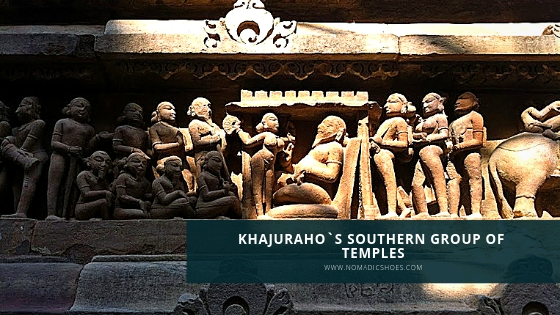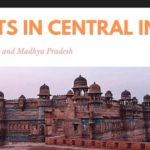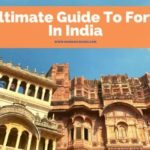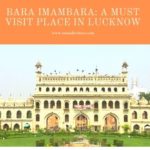
This is a part of my series on Khajuraho, you can read the previous article here: Khajuraho… a pilgrimage through art, architecture and history
“i doubt we are heading the right direction” – my travel partners concern was justified considering the lack of a tarred road and direction boards. Ahead of us was a field, a pond and a little beyond it was a construction site. We decided to continue our search for Bija Mandal.
Chatrabhuja Temple
We had just started our our temple tour of Khajuraho with Chatrabhuja temple or Chaturbhuj temple. This temple is a part of the southern group of temples and stands farthest away from the center of Khajuraho. I chose this as the starting point for the same reason as I wanted to finish the farthest first so that i can rely on my foot than the rented bike the next day.
Once I reached my destination, I realized that Khajuraho is more than just a place. Like a successful artist who manage to surprise the audience with every step, Khajuraho surprised me yet again. After an unknown geological marvel, the Raneh waterfall and its various coloured stones, this time it was the turn of a man-made temple. What I thought was a logical way to start exploring turned out to be more dramatic, like the unveiling of a plot in a well scripted play.
Chaturbhuj temple is the only temple in the 22 preserved temples in Khajuraho, lacking the erotic sculptures for which this place is famous among tourists. A brilliant point to start the tour, without being influenced into a biased view of these marvelous sculptures!
Constructed modestly with a sanctum and an entrance porch, this temple lacks no less in majesty as compared to others nor in terms of the famed sculptures. What lacks for size is compensated by the location, the hills lining the horizon and the open space between. If you are flying into Khajuraho, i believe you will see this beautiful temple on the port side of the craft. I am assuming this as we rode across the Approach Lighting System (the lights just before the runway) while heading to this temple.
Though a Christian by birth, I was always enticed by the stories of Hindu mythology, especially that of Lord Vishnu, one of the holy trinity of Hindu gods. Lord Vishnu is more popular in South-India – the followers often addressed as Vaishnavites. I remember reading about war and bloodshed between Vaishnavites & Shaivites (followers of Lord Shiva) over centuries, especially a fight few centuries back at Kumbh Mela.
Needless to say, I was amazed to know that this temple was dedicated for Lord Vishnu, the one with four (chatur) arms (bhuj). Further, the lack of erotic sculptures on a Vishnu temple, whose avatars redefined romance and sexuality (like Lord Krishna or Mohini), while the presence of the same in temples for Brahma, Shiva and other gods intrigued me. However, I couldn’t find any reason for this. Considering the size and the year of construction, it might be lack of resources or the decline of Chandela Dynasty.
While at the temple, a guide walked in with few tourists and started explaining the sculptures and the reasons of their existence in this temple. Much of it appeared to be hearsay or made up facts. I preferred online research over their ‘expert’ comments and started to walk down the stairs of the temple. Suddenly, the guide took out a mysterious tool which caught my attention.
Guides in Khajuraho carry a small pocket mirror and use the reflected light to point at the sculptures while explaining the history and ‘interesting’ facts. Considering that the idol and the entrance of this shrine face south, they will rarely run out of this natural pointers. I was impressed by this innovative method. I would love to hear from you of any other place where this method is practiced by guides.
I stopped for few seconds, observing the guide explaining the sculptures. He was pointing at the two sculptures, partly destroyed, on either side of the door to the sanctum. One was goddess Ganga and the other, goddess Yamuna. To think of it, sculptures reflect the society’s view and rivers were considered as celestial beings, reflecting the utmost importance of river for humans. Sadly, religious experts of this era is only concerned about the holy tags than their importance for our existence. The sculpture of Ganga and Yamuna can be differentiated by the presence of alligator and Yamuna with the depiction of tortoise at their foot. The fineness of the sculpture and its placement at the door to the sanctum clearly depicts how rivers were the lifeline of civilization in that era.
As I was clicking pictures of the beautiful sculptures & the exquisite design of the entrance porch ceiling, a man in plain clothes approached us and started talking to us about the history of this temple. Later during the conversation, he claimed that he is employed with ASI (which I doubt) and suggested we visit Bija Mandal before proceeding to the Eastern Group of Temples. Subtly, he also suggested that we could leave any amount at the deity’s statue for ‘blessings’. Out of courtesy, I left a 10 rupee note and left this beautiful temple.
Once outside, we retraced our path and took a right turn towards Bija Mandal as directed by the local we met inside Chaturbhuja temple. As we rode on, we saw fields and a pond with a construction site beyond the pond. The tarmac had already disappeared. Yet we decided to move on, slightly ahead, we saw a board on the fence warning us that the place is owned by ASI, we were happy.










